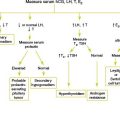Chapter 20 HEADACHE
General Discussion
Acute recurrent headache occurs when there are recurring episodes of head pain separated by symptom-free intervals. Most acute recurrent headaches in children are either migraine or tension-type headaches. The International Headache Society diagnostic criteria for migraine headache are outlined in Table 20-1. The diagnostic criteria for pediatric migraine without aura are outlined in Table 20-2. The diagnostic criteria for episodic tension-type headache are outlined in Tables 20-3 and 20-4.
Table 20-1 International Headache Society Diagnostic Criteria for Migraine with Aura
Table 20-2 2004 International Headache Society Criteria for Pediatric Migraine without Aura
Table 20-3 2004 International Headache Society Diagnostic Criteria for Infrequent Episodic Tension-Type Headache
Table 20-4 2004 International Headache Society Diagnostic Criteria for Frequent Episodic Tension Type Headache
Medications and Drugs Associated with Headache
Causes of Headache
Acute Headache (note that causes of acute headache can also cause acute recurrent headache)
Short-lasting unilateral neuralgiform headache attacks with conjunctival injection and tearing (SUNCT) syndrome
Key Historical Features
 Worrisome features and red flags include the following:
Worrisome features and red flags include the following:
 Exacerbating and alleviating factors
Exacerbating and alleviating factors
 Nausea with or without vomiting
Nausea with or without vomiting
 Days of school missed because of headache
Days of school missed because of headache
 Triggers: stress, food, hunger, fatigue, under/over sleeping
Triggers: stress, food, hunger, fatigue, under/over sleeping
 Any changes from previous headache pattern
Any changes from previous headache pattern
 Medications (especially type and frequency of analgesic use)
Medications (especially type and frequency of analgesic use)
Key Physical Findings
 Vital signs, especially for the presence of fever or hypertension
Vital signs, especially for the presence of fever or hypertension
 Measurement of head circumference and evaluation of growth parameters
Measurement of head circumference and evaluation of growth parameters
 Funduscopic examination for papilledema
Funduscopic examination for papilledema
 Thorough neurologic examination, including:
Thorough neurologic examination, including:
 Head examination for scalp tenderness, sinus tenderness, lymphadenopathy, or tenderness at the temporomandibular joint. Note the patient’s dentition for caries or abscess
Head examination for scalp tenderness, sinus tenderness, lymphadenopathy, or tenderness at the temporomandibular joint. Note the patient’s dentition for caries or abscess
Additional Work-up
| Complete blood cell count (CBC) and blood culture | If a serious infectious process is suspected |
| Lumbar puncture | Necessary if meningitis is suspected |
| Emergent computed tomography (CT) scan followed by lumbar puncture if the CT is normal | If the patient has altered mental status or focal findings on examination |
| Magnetic resonance imaging (MRI; preferred) or CT scan | For any child suspected of having an intracranial space-occupying lesion or elevated intracranial pressure. Indications for imaging children with headaches are outlined in Table 20-5 |
| Ventriculoperitoneal (VP) shunt tap | May be required for a child with a VP shunt and headache |
| Electrocardiogram, electrolytes, and urinalysis | For the child with headache and hypertension |
| Noncontrast head CT followed by lumbar puncture if CT scan is negative. Consider coagulation studies and a platelet count. | If subarachnoid hemorrhage is suspected |
| Blood glucose | If hypoglycemia is suspected |
| Toxicology screen | If drug use or toxin exposure is suspected |
| Carboxyhemoglobin level | If carbon monoxide exposure is suspected |
| Lead level | If lead toxicity is suspected |
| Sinus or dental x-rays | If sinusitis or dental infection is suspected, though empiric therapy is a reasonable alternative to imaging |
| EEG | May be indicated if complex partial seizures are suspected or the headache is associated with an alteration in consciousness or abnormal involuntary movements |
Table 20-5 Indications for Imaging Children with Headaches
|
|
1. Anttila P. Tension-type headache in childhood and adolescence. Lancet Neurol. 2006;5(3):268–274.
2. Gladstein J. Headache. Med Clin North Am. 2006;90(2):275–290.
3. Headache Classification Subcommittee of the International Headache Society. The international classification of headache disorders, 2nd ed. Cephalalgia 2004;24:9–160.
4. Lewis D.W. Headaches in children and adolescents. Am Fam Physician. 2002;65(4):625–632.
5. Lewis D.W., Rothner A.D. Headache in children and adolescents. In Johnson R.T., Griffin J.W., McArthur J.C., editors: Current Therapy in Neurologic Disease, 6th ed., St. Louis, MO: Mosby, 2002.
6. Lewis D.W., et al. Practice parameter: evaluation of children and adolescents with recurrent headache. Neurology. 2002;59:490–498.
7. Lewis D., et al. Practice parameter: pharmacological treatment of migraine headache in children and adolescents. Report of the American Academy of Neurology Quality Standards Subcommittee and the Practice Committee of the Child Neurology Society. Neurology. 2004;63:2215–2224.
8. Lipton R.B. Classification of primary headaches. Neurology. 2004;63(3):427–435.
9. Mortimer H.J., Kay J., Jaron A. Epidemiology of headache and childhood migraine in an urban general practice using ad hoc, Vahlquist, and HIS criteria. Dev Med Child Neurol. 1992;34:1095–1101.
10. Qureshi F. Managing headache in the pediatric emergency department. Clin Ped Emerg Med. 2003;4:159–170.
11. Sackhara T. Pediatric SUNCT syndrome. Pediatr Neurol. 2005;33(3):206–207.
12. Schobitz E. Pediatric headaches in the emergency department. Curr Pain Headache Rep. 2006;10(5):391–396.
13. The Childhood Brain Tumor Consortium. The epidemiology of headache among children with brain tumor. Headache in children with brain tumors. J Neuro-oncol. 1991;10:31–46.
14. The International Classification of Headache Disorders. 2nd ed. Cephalalgia 2004;24:1–160.
15. Wilne S., et al. Presentation of childhood CNS tumours: a systematic review and meta-analysis. Lancet Oncol. 2007;8(8):685–695.
16. Young W.B. Drug-induced headache. Neurol Clin. 2004;22(1):173–184.
17. Zuckerman B., Stevenson J., Bailey V. Stomach aches and headaches in a community sample of preschool children. Pediatrics. 1987;79:677–682.



































